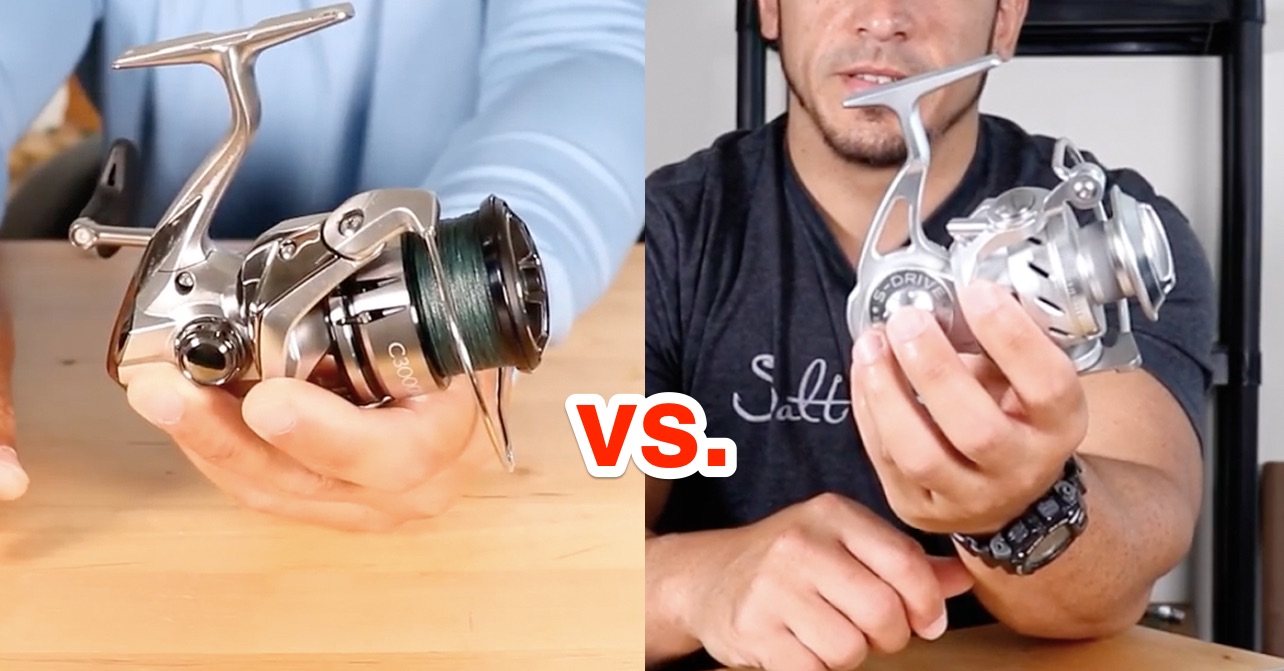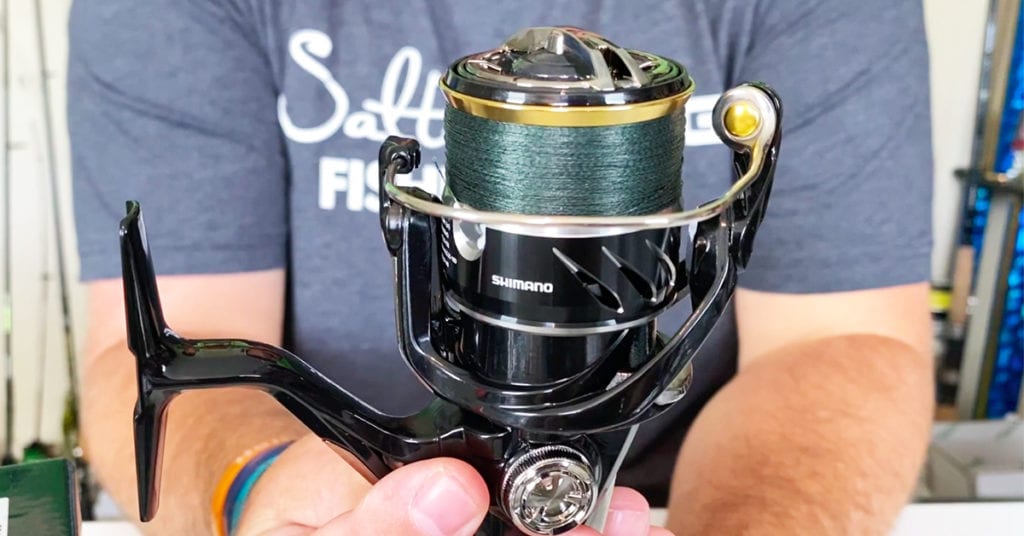High-Speed vs. Low-Speed Spinning Reels (Pros & Cons Of Each)
- By: Tony Acevedo
- on

One important, but often underlooked, aspects of a fishing reel is the gear ratio and how fast it is.
The speed of a reel should match the type of fishing you’re doing, and if it’s unmatched (or you’re unaware of the speed), then it could be costly.
For example, if you’re throwing a paddletail and using a high-speed reel that you’re not used to, but are cranking the handle at the same cadence that you would with a slower reel, you might actually be retrieving your lure way too fast, which could cause you to not get any strikes.
That’s just one example — there are several other things to keep in mind when fishing low vs. high-speed reels, and we’ll cover those applications, as well as the advantages and disadvantages of each in this video.
If you’re thinking about getting a new reel, definitely check out this video first.
High-Speed vs. Low-Speed Reels [VIDEO]

Before we talk about the advantages and disadvantages of the different speeds, let’s get some baseline knowledge first.
The speed of a reel is all about gear ratio, which determines how many times a spool will spin per crank of the handle, which determines how much line is picked up.
For example, in this video, I was holding a Shimano Stradic FL 3000 that has a 6.4:1 gear ratio.
That means that for every crank of the handle, the line wraps around the spool 6.4 times, which means that the reel picked up 37-38 inches of line.
If a reel had a gear ratio 5:1, and the same size spool, then for every crank the reel would pick up about 29 inches of line.
So in this example, that’s a difference of nine inches per crank, which is pretty significant.
High-Speed vs. Low-Speed Reels: Advantages & Disadvantages
I use high-speed reels most of the time, mainly because they’re more versatile.
But low-speed reels have their place, too.
Here are some basic advantages and disadvantages of each:
Advantages of high-speed reels:
- If you hook into a fish close to structure, you can get them away from it quicker
- If a fish strikes your lure then comes swimming toward you, a high-speed reel makes it easier to reel in the slack and get tension on the fish so you get a good hook set
- If you make a cast, but then see a fish swim right by you, you can get your lure back in quickly and cast to the fish
Disadvantage of high-speed reels:
- It’s very easy to retrieve lures too fast
Advantages of low-speed reels:
- It’s easier to retrieve your lure slowly (this is especially good for wintertime fishing)
- It’s harder to retrieve your lure too fast
Disadvantage of low-speed reels:
- If you need to reel in line quickly, it’s much harder to do with a low-speed reel
Conclusion

Most people use high-speed reels, but each speed has its place.
If you’re thinking about getting a new reel, take the above pros and cons into consideration, as well as your style of fishing before you decide on a reel.
Have any questions about high-speed vs. low-speed reels?
Let me know in the comments below!
And if you know someone who would like to learn more about fishing reels, please TAG or SHARE this with them!
P.S. Want access to our best fishing spots and tips, plus discounts to our online tackle store? Click here to join us in the Insider Club!
Stop Wasting Your Valuable Time On The Water!
Do what the “SMART ANGLERS” are doing and join the Insider Club.
Here’s what you’ll receive today when you join:
- Weekly fishing reports and TRENDS revealing exactly where you should fish ever trip
- Weekly “spot dissection” videos that walk you through all the best spots in your area
- Exclusive fishing tips from the PROS you can’t find anywhere else
- 20% OFF ALL of your fishing tackle (rods, reels, line, lures, and more from ALL of the biggest brands in America)
Click here to join today.
Related articles:
Related categories:
STOP WASTING TIME ON THE WATER!
Do what the “SMART ANGLERS” are doing and join the Insider Club.
Here’s what you’ll receive today when you join:
- Weekly fishing reports and TRENDS revealing exactly where you should fish every trip
- Weekly “spot dissection” videos that walk you through all the best spots in your area
- Exclusive fishing tips from the PROS you can’t find anywhere else
- Everything you need to start catching fish more consistently (regardless if you fish out of a boat, kayak, or land).










Nice info. My reel repair shop told me that the ratio is a key technical aspect for durability. They advice to get the lowest gearing possible while having an IPT good enough for your tactics. In the US market there are not many options of medium-low gearing with high IPTs with good saltwater resistance. For example, for my Snook surf fishing, I use heavyish lures 1-1.5 oz and need an IPT of 35 in too move them efficiently. A prime example for this task is a Saragossa 5k, which has a gearing of 5.7:1 and an IPT of 38 in.
I basically look at the Inch Per Turn (IPT) and not the gear ratio anymore. A 6:1 gear ratio on a small spool can be slower than a 5.3:1 on a bigger spool. From my experience with reels, i’d say anything under 30 IPT is quite slow, which you can get from reels with 5:1 gear ratio if the spool is small. 30 – 36 IPT is probably an average retrieve speed. 37+ is where you start to approach the faster speeds.
A mate of mine has a Daiwa BG 8000 which has 53 IPT and that reel is super fast. One of my reels goes about 38 IPT and in my opinion that’s about the perfect balance. I think for big stickbaits and poppers when targeting aggressive predators like Trevally, having speeds in excess of 40 will be ideal!
Size of the spool can definitely play a role!
.
Have you ever heard of diwa reels 3000
How much of a speed difference are we talking? Like a 5.3 to a 6.2? Is that enough to even bother with going to the high speed? All the reels I have are 6+ but I tend to have to fish them slow all the time. I’m a quality fish guy. If it’s not over 22” I’d rather cut my line. Lol. I was thinking of going to a Fuego 3000 which I think is 5.3 or something like that but I’m scared of I get into a bull or a gator and it runs at me I’m going to loose the fish.
I’ve heard that high speed reels (like a 7:1 or 8:1)have less torque than a lower speed reel so it’s easier to crank a fish out of cover in certain situations with a lower speed reel. I also usually use higher speed reels but wasn’t sure if this is really true about the torque aspect. I fish only inshore so this isn’t much of an issue for me but thought I’d mention it as a possible other point of consideration when choosing a reel.
Yep the lower the ratio the more torque. However, I only find the “torque” aspect to apply to bait casters and conventional reels, since they are basically like a winch. The way a spinning reel takes in line just doesn’t seem to get the job done like a conventional reel would to crank down on a fish (which is why conventional reels are much better suited for bottom fishing/deep sea fishing to crank those fish up)
This totally makes sense now. I have two reels (with two rods obviously) and my Diawa LT 2500 has a ratio of 5.3:1. I just bought a Shimano Stradic FL 3000 with the 6.4:1 ratio. Went fishing a week back and found that I had to reel significantly slower with the new reel to keep the slam shady (yeah I said it, take a shot) from racing by the fish. Caught two really nice trout from shore (Kelly Park, Brevard, County). I’ve never paid attention to those numbers before because I’m relatively inexperienced in all the ratios, fast, slow action, whatnot. I sure do miss my zebco 101.
Glad the info helped clear some things up Joseph!